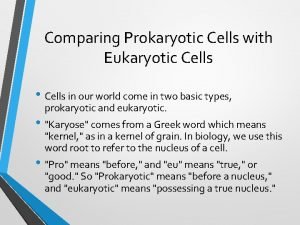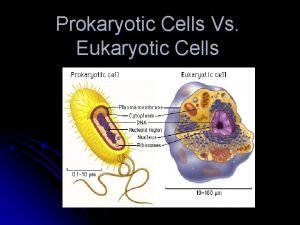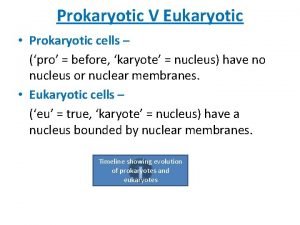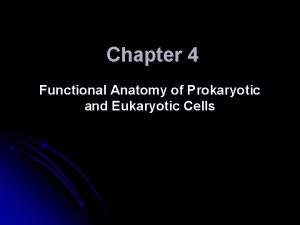Prokaryotic V Eukaryotic Prokaryotic cells pro before karyote

Prokaryotic V Eukaryotic • Prokaryotic cells – (‘pro’ = before, ‘karyote’ = nucleus) have no nucleus or nuclear membranes. • Eukaryotic cells – (‘eu’ = true, ‘karyote’ = nucleus) have a nucleus bounded by nuclear membranes. Timeline showing evolution of prokaryotes and eukaryotes

Structure of a generalised bacterial cell Nucleoid – general area where DNA lies Plasmid –small circular piece of DNA Label your diagram

Comparisons. . Prokaryotic cells • No true nucleus, only diffuse area(s) of nucleoplasm • No nucleolus • Circular strands of DNA but no proteins to make up chromosomes • No membrane bound organelles • No chloroplasts, only photosynthetic lamellae in some bacteria • Ribosomes are smaller (70 S) • Flagella if present lack internal 9+2 microtubule arrangement • No ER or associated Golgi apparatus and lysosomes • Cell wall made of peptidoglycan Eukaryotic cells • Distinct nucleus, with nuclear envelope • Nucleolus is present • Chromosomes present in which DNA is located, DNA molecules linear • Membrane bound organelles are present • Chloroplasts present in plants and algae • Ribosomes are larger (80 S) • Undulipodia have 9+2 internal microtubule arrangement • ER present along with Golgi apparatus and lysosomes • Where present, cell wall is made mostly of cellulose or chitin.

Evolution of Eukaryotic Organelles Lynn Margulis

Prokaryotes and disease MRSA (methicillin-resistant Staphylococcus aureus) Resistance coded on plasmid DNA – bacteria can share plasmids with each other – pass on resistance to daughter cells during binary fission Prokaryotes that help Food industry Mammalian intestines Skin Sewage treatment
- Slides: 5








